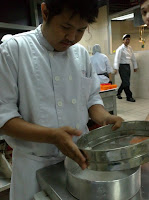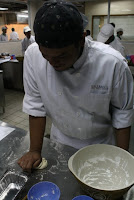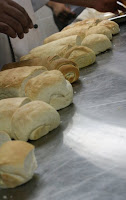1st Experiment : ANGEL CAKES
Assalamualaikum and Salam 1 Malaysia…
Date: 27th January 2011
On this date, we had done the first experiment to make “angle cakes”. Using the guideline book given by Chef Zaid, Each group has to make Angel Cakes by the same formula but in the different procedures.
Objectives of the experiment
Outline the best method for making an Angel Cake with optimum texture, volume, and tenderness.
Evaluate angel cakes according to accepted standards.
Relate the effect of mixing to the texture, volume and tenderness of Angel Cake.
Explain the role of cream tartar in Angel Cake.
Interpret the effect of sugar on flavor, tenderness, volume and texture of Angel Cake.
Describe the interrelationship of sugar (or alternative sweetener) and gluten development in Angel Cake.
Relate the effect of foam development on texture, volume, and tenderness of Angel Cake.
Explain the influence of baking conditions in determining quality of Angel Cake.
Compare the merits of all purpose and cake flour in preparation of Angel Cake.
The Basic formula of Angel Cake
Ingredients A
10g - Sugar15g - Cake Flour
Ingredients B
41g - Egg Whites32g - Sugar0.6g - Cream of Tartar0.1g – Salt
Method to make ANGEL CAKES
Preheat oven to 350'F (177'C) except for procedure 6, which has separate baking directions. Line the bottom of each individual loaf pan (5" x12 1/2" x2") with wax paper cut to just fit. Do not grease the sides of the pan.
Sift flour and first weight (10 g) of sugar together and set aside. Beat the egg whites together to the foamy stage, using an electric mixer (same kind for all parts of the experiment). Unless indicated differently in a specific series, add the cream of tartar and salt. (Note: if it were being used, flavoring would be added with the cream of tartar). Continue beating on the fastest mixer setting while gradually adding 32 g sugar. Beat the whites until the peaks just bend over.
Sift 1/4 of the flour-sugar mixture over the whites. Fold in gently with 10 strokes using a rubber spatula.
Sift the second 1/4 of the flour-sugar mixture over the whites and fold in gently with 10 strokes, followed by the same process for the third addition.
Sift the final 1/4 of the flour-sugar mixture over the foam and fold 20 strokes to completely blend the mixture (making a total of 50 folding strokes with the rubber spatula).
Gently push and weight 99 g of the batter into the pan. Finish all of the cakes being baked in one oven before placing them all in the oven at the same time.
Baking until the surface springs back when touched lightly with a finger (-30 minutes). Record the baking time.
Cool in an inverted position with air circulating under the pan. When almost cool, remove from the pan.
Before the experiment, we are having a short briefing about the experiment on what we are going to do on that day. Groups are all divided into 5 with different tasks.
Task implementation
Before the experiment
After we have form our group consist with 5 student, Chef Zaid give us some briefing about the experiment using the experiment book. Each group get different task given by Chef Zaid. We have divided the task to our group member.
Task for our group:
Varying the amount and type of flour
(4.c) Increased cake flour - Prepare the basic formula, but increase cake flour to a total of 20g.
(4.d)Cornstarch - Prepare the basic formula, but omit cake flour and replace with 15g of cornstarch.
Varying sugar
(5.a) Reduced sugar – prepare the basic formula, but use only 8g for the first sugar weight and only 26g sugar for the second weight.
(5.b) Increased sugar – prepare the basic formula, but use only 8g for the first sugar weight and only 26g sugar for the second weight.
(5.c) excess sugar – prepare the basic formula, but use only 8g for the first sugar weight and only 26g sugar for the second weight.
 |
listening Chef zaid Briefing |
 |
dividing the task to group member |
During the experiment
After we have divides the task to each group member we start to make the mise en plus the Angle Cake recipe. The amount of each ingredient must correctly sharp according the recipe in the experiment’s book. Incorrect amount of recipe can change the result of experiment.
 |
|
|
|
|
example of angel cake recipe according the task by chef Zaid |
 |
sifting flour before continue other method |
after the mise en place have done, we continue the experiment using the method in experiment’s book. The progress should follow the method correctly to avoid any unsatisfied result.
 |
mix the ingredient B and A using the mixer , according the method of recipe. |
 |
stroke the ingredient using the spatula. |
After finish mix the ingredient, we need to measure the weight of the mix ingredient before baking it in the oven. Put the mix ingredient in the pan, the weight has been record in the experiment’s book.
 |
| the mix ingredient should be measured and record |
 |
| shape and weight the angel cake before baking in oven |
Record the baking time, check the angel cake with stick to make sure the cake is baked. After the angel cake are baked, measured the weight each of angel cake again before continued other experiment procedure.
 |
| waiting for the cake to baked. |
 |
| shape and weight the angel cake after baked |
 |
| Final result for other experiment procedure. |
After the experiment
After the experiment have done. All students will compare their result according their task. We record the final result and chef Zaid give us more briefing about the experiment that we made today. The reaction about each of method or ingredient can give variety of result that can affect the angel cake texture, exterior and tenderness
Recommendation for our group task
The type and the different amount of flour will affect the cake after baked, the experiment in our group made has proved, if we look from the final result.
Amount of flour in the cake should suitable with amount of water in the recipe to achieved better texture, exterior and tenderness cake, if the water are more than amount of flour the cake will be more soft and nice to chews.
Cornstarch is one type of flour that is not suitable to use for making cake. It will make the cake become chewier.
Increasing amount of sugar will make the cake become crunchy, this is not suitable to make cake using high amount of sugar. Used suitable amount of sugar to get better result of cake, moreover cake contain high of amount sugar are not healthy for our body.



































